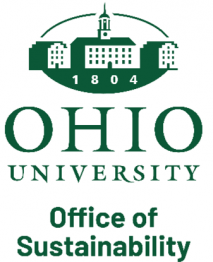
Sustainability and Climate Action Plan

2021 OHIO
Sustainability and Climate Action Plan
Approved June 18, 2021
Executive Summary
Background
Planning Process
How to Read the Plan Categories
Categories in the Plan
Implementation and Tracking
Acknowledgements
Condensed List of Plan Goals
Executive Summary
The 2021 OHIO Sustainability & Climate Action Plan is a road map for the next 5 years of progress toward the carbon neutrality and academic requirements of the Presidents’ Carbon Commitment (formerly the American College and University Presidents’ Climate Commitment) and the OHIO strategic priority of “enhancing the University’s national position as a leading edge laboratory for sustainability.” The plan challenges the University to reach new targets beyond those included in the 2011 Sustainability and 2012 Climate Action Plans.
To streamline external reporting and facilitate national recognition, the plan aligns with the Association for the Advancement of Sustainability in Higher Education (AASHE) Sustainability Tracking, Assessment, and Rating System (STARS) credits as well as the United Nations Sustainable Development Goals (SDGs).
The sixteen sections of the plan are: Administrative Support, Buildings, Climate, Curriculum, Energy, Engagement, Food, Grounds, Human Resources, Investments, Procurement, Research, Student Life, Transportation, Waste and Water. Goals are included in each section of the plan along with metrics, targets, strategies for reaching those goals as well as general triple bottom line costs and benefits of implementing the strategies. The plan will be partnered with an internal implementation document which will be more fully developed over the next academic year.
The creation of this document was a University and community-wide effort, informed by more than 450 comments from faculty, staff, students, and community members with valuable feedback integrated into the plan.
Guiding principles for the 2021 OHIO Sustainability & Climate Action Plan were:
- The new plan must direct progress toward the achievement of the Presidents’ Carbon Commitments.
- The new plan must merge and align the goals of the former Ohio University Sustainability Plan, Ohio University Climate Action Plan and the AASHE STARS submissions to minimize duplicate reporting requirements.
- The new plan must provide triple bottom line cost benefit analyses for strategies, to aid in implementation decisions.
Strengths of this plan lie in the expansion of sustainability goals to include issues such as diversity and inclusion in the Human Resources and Student Life areas; in the incorporation of flexible experiential and community-engaged learning laboratory strategies in both the plan and in the implementation process; and in the focus on strategies that simultaneously benefit the triple bottom line of sustainability: people, planet and prosperity, now and into the future.
Background
Ohio University is known for its strong commitment to sustainability, evidenced in part by its founding of Recycle Mania with Miami University in January 2001, its listing on the Top 30 College & University US EPA Green Power Partner list, its status as home to the largest in-vessel composting system of any college or university in the nation, and its support of sustainability focused research and curriculum. The university has almost 1 million square feet of Leadership in Energy & Environmental Design (LEED) certified building space. Ohio University has achieved numerous sustainability accolades, including: AASHE STARS Silver status for the past six years; Tree Campus Higher Education recognition for the fifth straight year; Bicycle Friendly University for the past three years; recognition as a LEED Lab institution; a national Gameday Recycling Challenge repeat winner; and a Platinum Ohio EPA Encouraging Environmental Excellence recognition. Ohio University is a past winner of the APPA Sustainability Award and the NACUFS bronze award for Waste Management.
Former President Roderick McDavis signed the American College and University Presidents’ Climate Commitment, now called the Presidents’ Carbon Commitment, on March 15, 2007, committing the University to:
- creating and updating a climate action plan to achieve carbon neutrality
- annual carbon tracking and reporting
- actions to make carbon neutrality part of the curriculum for all students
- actions to expand research in carbon neutrality
The first Ohio University Sustainability Plan was created through an extensive public planning process and was approved by the Board of Trustees in 2011. The first Ohio University Climate Action Plan was then created the following year in 2012 to meet the Carbon Commitment requirements.
More recently, Former President Duane Nellis reaffirmed Ohio University’s Carbon Commitment on his first day in office, June 12, 2017, by signing the “We are Still In” declaration of continued commitment to reaching carbon neutrality.
Planning Process
The 2021 OHIO Sustainability and Climate Action Plan was created after an extensive planning process. Initial development began in 2016 by defining guiding principles and creating a timeline for plan completion. Despite consistent advances, we extended our process several times, first in response to faculty requests, then to needs of administrators and to navigate structural changes, and finally due to circumstances caused by the COVID-19 pandemic.
Guiding principles were:
- The new plan must direct progress toward the achievement of the Presidents’ Carbon Commitments.
- The new plan must merge and align the goals of the former Ohio University Sustainability Plan, Ohio University Climate Action Plan and the AASHE STARS submissions to minimize duplicate reporting requirements.
- The new plan must provide triple bottom line cost benefit analyses for strategies, to aid in implementation decisions.
The final planning process timeline included goal and target envisioning, vetting by responsible parties and the public as well as multiple revisions over a two-year period, as is shown in Figure 1.
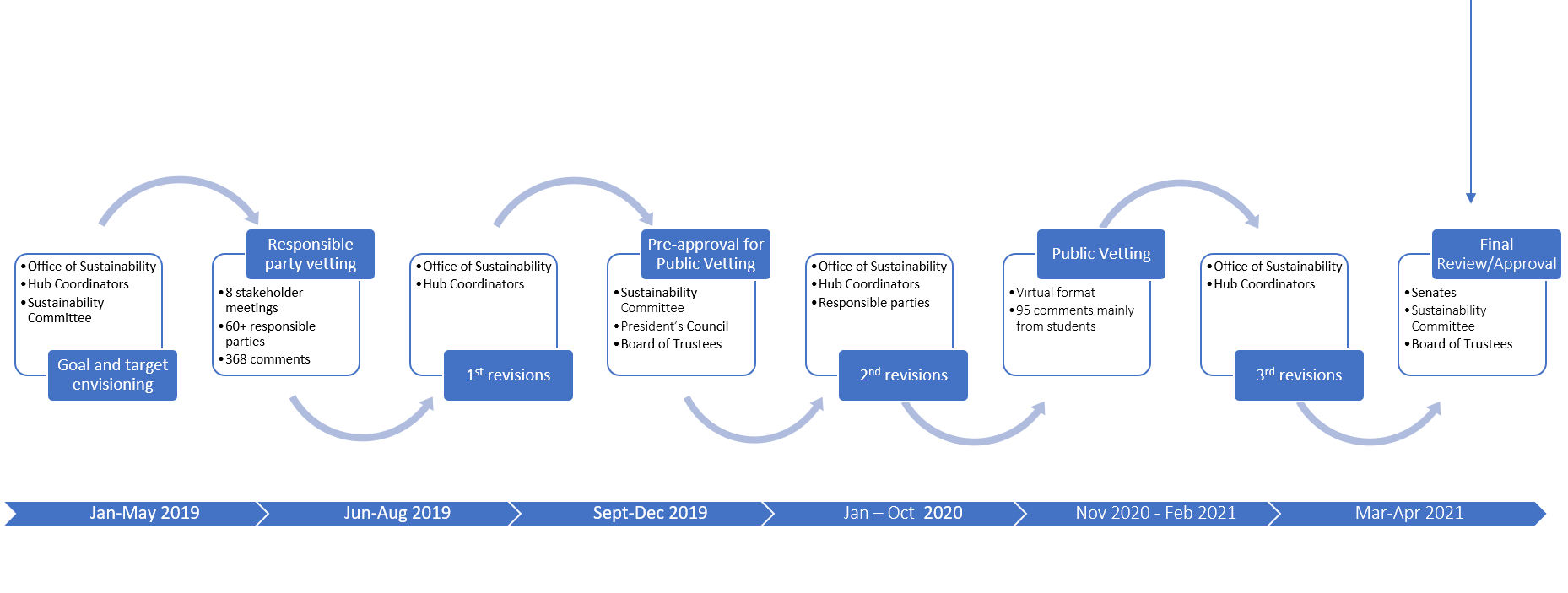
How to Read the Plan Categories
Categories in the Plan
Sustainability at Ohio University is structured into core components and Sustainability Hubs. There are three Sustainability Hubs, each led by a faculty member and comprising 4 thematic categories. The thematic categories in the core components and Sustainability Hubs are listed below in alphabetic order by core/Hub. Click the heading to download each section of the plan.
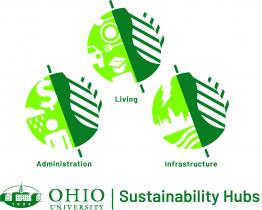
Administrative Support
Curriculum
Engagement
Research
Sustainable Administration Hub Categories
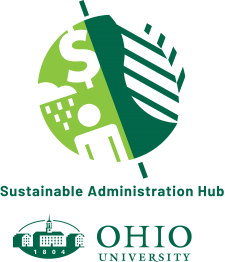
Climate
Human Resources
Investments
Procurement
Sustainable Infrastructure Hub Categories
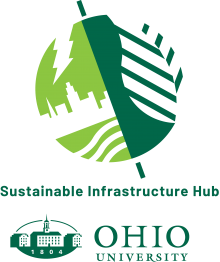
Buildings
Energy
Waste
Water
Sustainable Living Hub Categories

Food
Grounds
Student Life
Transportation
Implementation and Tracking
A plan achieves success when it is complemented by an effective implementation process. The 2021 OHIO Sustainability & Climate Action Plan will be implemented by administrators, faculty, students, and staff throughout the University. Implementation will be facilitated and tracked by the Office of Sustainability and the Sustainability Hubs.
In the 2021-22 academic year, detailed implementation guides will be developed for each category in the plan. The guides will include names of parties who have agreed to implement strategies, the specific metrics that will be gathered to determine progress on those strategies, implementation notes, and how the metrics from each strategy will be compiled to determine overall progress toward the plan goals. The Office of Sustainability Director and Associate Director will each facilitate implementation of eight categories, with assistance from the Sustainability Hub Coordinators, Sustainability Hub Graduate Assistants, and other student staff.
Implementation facilitation will also occur through the Sustainability Project Laboratory (SPL). Strategies will be listed in the SPL as either ideas to be developed into implementable projects, or full projects which are ready to be implemented by graduate students, as class projects, or as student organization projects. Strategy lists are designed to be flexible and to change over time. Strategies will move fluidly from the ideas section of the SPL into the full project section, to webpages as they are implemented, or perhaps back to the ideas section, as resources and priorities change.
Parties responsible for implementation from around the University will be contacted on an annual basis to gather metrics on progress. Metrics will be compiled and compared to targets for each goal in each category on an annual basis and will be reported in one or more of the following ways:
- Second Nature’s Annual Presidents’ Carbon Commitment Report
- Ohio University Board of Trustee’s Annual Sustainability Report
- Ohio University Bi-annual Sustainability Committee Report
- AASHE STARS Tri-annual Report
- Office of Sustainability webpages
The creation of this plan was a labor of love, and we are grateful to the following people for their contributions. Apologies if we have forgotten anyone; there were so many contributors!
Office of Sustainability Staff
Sam Crowl
Elaine Goetz
Ryan Fogt
Theresa Moran
Dave Bayless
Kim Thompson
Benton Wright
Meg Little
TJ Vanek
Olivia Wolff
Allison Shryock
Emma Linn
Andy Mayse
Vicky Kent
Abbey Rodjom
Sydney Hutchinson
Vanessa Thiel
Ecohouse Residents
Paola Munoz
Tristan Mandeville
Elle Dickerman
Faculty and Staff
Joel Baetens
Cliff Hamilton
Tia Hysell
Andrew Ladd
Lindsey Rudibaugh
Mary Nally
Jennifer Bowie
Tina Payne
Steve Mack
Shawna Wolfe
Jennifer Bennett
Annie Laurie Cadmus
Susan Calhoun
Catherine Marshall
Matthew Riley
Jacqueline Kloepfer
Catherine Allgood
Dominick Brook
Jonathon Cozad
Sarah David
Janet Hulm
Miranda Kridler
Jason Farmer
Joy Kostansek
Natalie Kruse Daniels
Diana McGrew
Rusty Thomas
Barbel Such
Elissa Welch
Nicole Kirchner
Thomas Stevenson
Pramod Kanwar
Nancy Manring
Gwyn Scott
Michael Stephens
Katherine Hartman
Sara Helfrich
Eric Burchard
Kathy Fahl
Barbara Harrison
Jim Sabin
Gigi Secuban
Geneva Murray
Jill Lallier
Mark Ferguson
David Gaume
David Stowe
Ana Rosado-Feger
Colleen Bendl
Cat Russell
Peter Trentacoste
Arthur Trese
Megan Vogel
Geoff Dabelko
Jeremy Daniels
Jesus Pagan
Brent Buckley
Greg Kremer
Adam Riehl
Jay North
Jeff McGlamery
Roxanne Male-Brune
Kelly Broughton
Jen Bowman
Becky Bushey-Miller
Valerie Miller
Jenny Hall-Jones
Jason Pina